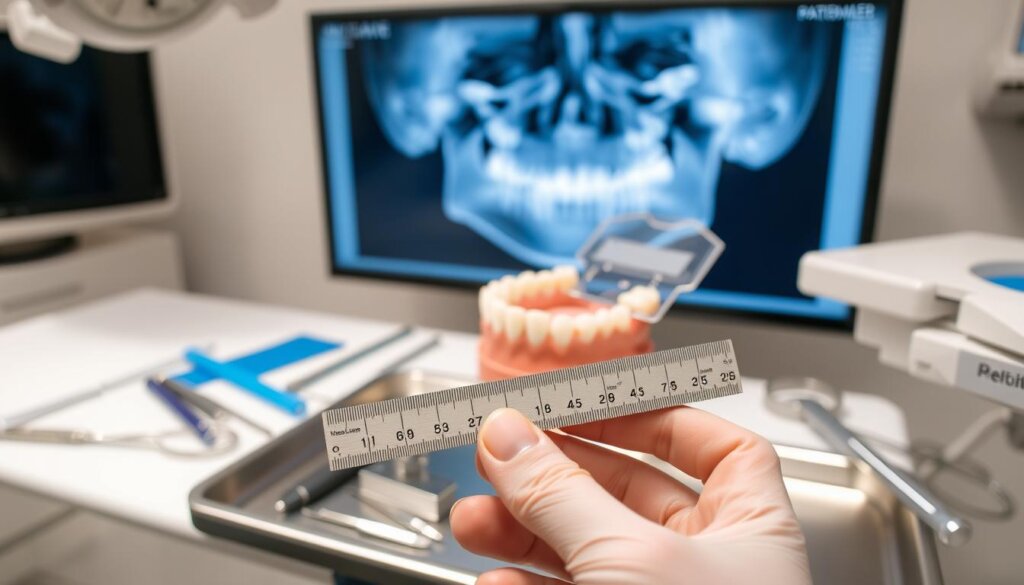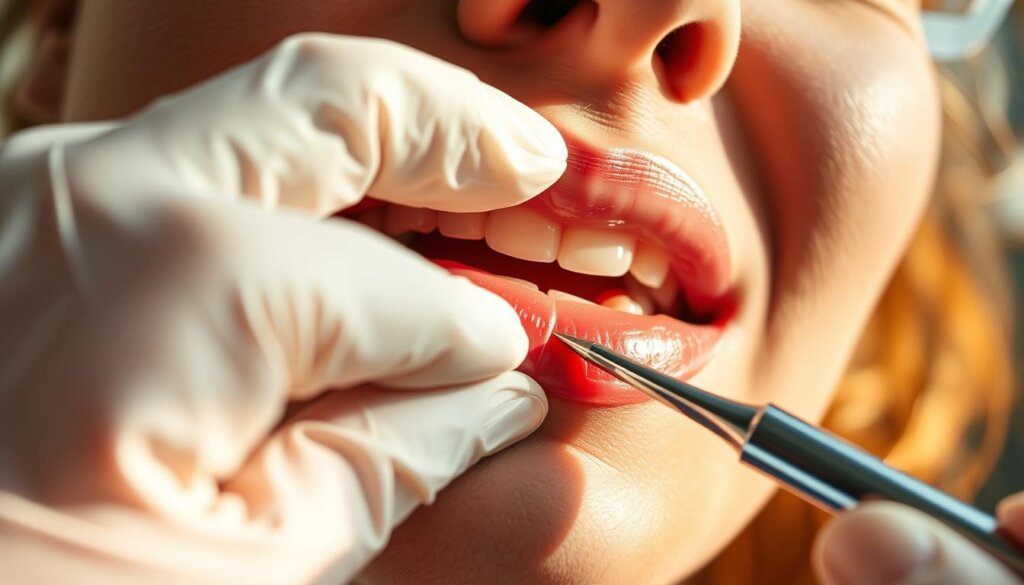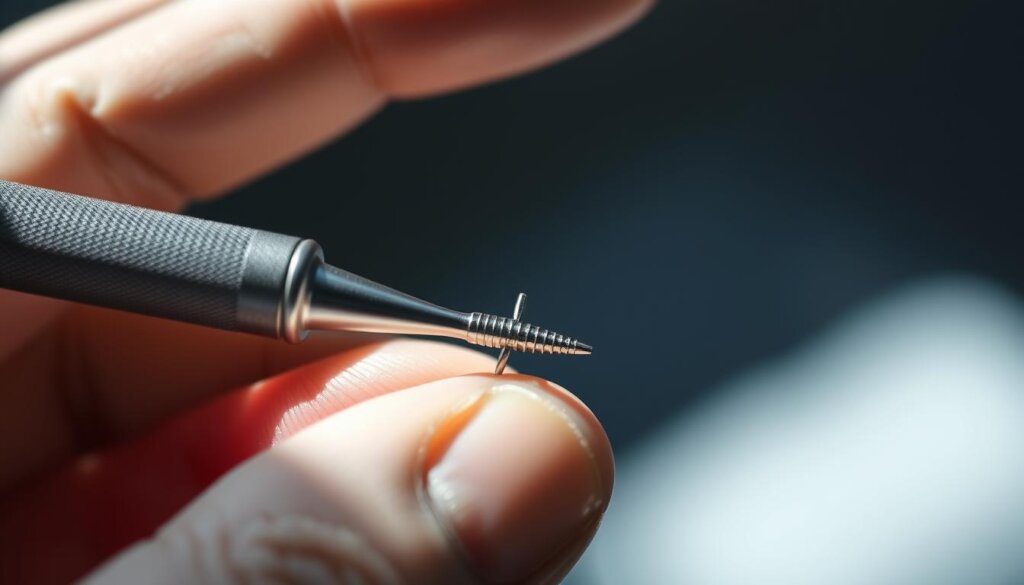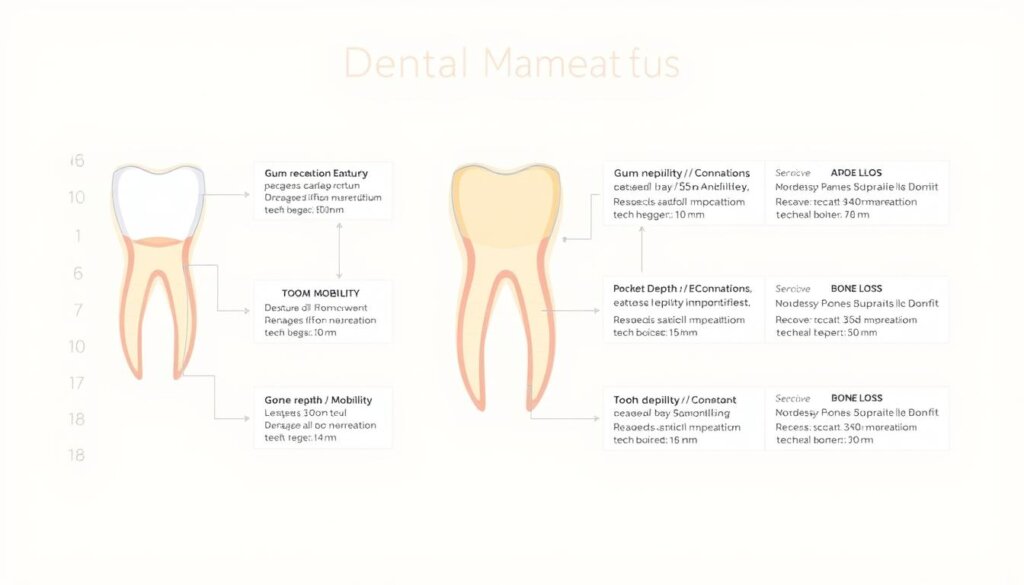What Measurements Does the Dentist Call Out?
Ever hear “two, three, four” during a cleaning and wonder what it means? Or if a single number could tell you about your gum health?
Those numbers aren’t just any numbers. They come from periodontal assessments during a dental exam. They show how healthy your gums and the bone underneath are. Dentists measure the space between your gums and teeth in millimeters, checking six spots per tooth. They also look for signs of bleeding or if the gums have pulled back.
When you’re sitting in the chair, you might hear the dentist or hygienist call out numbers like 1–3, 4, or 5–7. Numbers between 1 and 3 mm mean your gums are healthy. A 4 mm reading hints at the start of gum issues. If the numbers are higher, or if there’s bleeding or your gums are pulling away, it points to possible gum disease. This could mean you need more tests, special treatments, or even surgery. Knowing what these numbers mean helps you understand your gum health. It also helps your dental team track any changes over time.
These numbers help your dentist figure out the best care plan for you. This might be just regular cleaning, more intensive treatments, or surgery. Keeping track of these numbers helps prevent serious problems, keeps your teeth where they should be, and contributes to your overall health.
Key Takeaways
- The numbers called out are periodontal assessments. They measure the space between your gums and teeth at six points per tooth.
- Healthy gums usually have numbers between 1 and 3 mm. Readings of 4 mm or more need extra attention.
- Signs like bleeding when the dentist measures or gums pulling back tell more about your gum health.
- Keeping track of these numbers helps dentists spot problems early. This can help save your teeth.
- Understanding these measurements lets you ask better questions and make informed choices about your dental care.
- Good records help dentists create the right treatment plan for you, from basic care to more advanced treatments.
Understanding the Dental Exam Process
Your visit starts by looking at your medical history and current symptoms. Then, a thorough check of your oral health follows. Dentists follow a set plan to check your mouth and track any changes over time. This helps them provide the best care.
The dental team uses a special tool to measure your gum health around each tooth. They write down these measurements. The results help decide if you need dental X-rays. They also help plan your next visit for prevention.
Importance of Regular Dental Checkups
Regular checkups help catch gum diseases early thanks to detailed measures. These visits let dentists monitor your oral health over time, not just at one appointment. They also teach you how to take care of your teeth at home. This can help you avoid emergency dental visits.
- Prevention first: cleanings reduce harmful bacteria and swelling.
- Trend tracking: repeated checks reveal small changes.
- Personalized care: treatments are based on your specific needs.
What to Expect During an Exam
The dentist will gently check your gums at six spots for each tooth and note the measurements. They mark down any bleeding. This helps understand your overall gum health. If they find issues, they might take X-rays to check your bones.
- Reviewing medical and dental history helps tailor your treatment.
- A dental hygiene check looks at plaque, tartar, and gum health.
- Charting the gums with precise measurements.
Types of Measurements Taken by Dentists
Dentists use exact measurements during check-ups to see how healthy your gums are. They use special tools to find out what care your teeth need. There are two main kinds of measurements that tell a lot about your gum health.
Pocket Depth Measurement
One way dentists check your gums is by measuring pocket depths. They use a tool to measure how deep it goes between your tooth and gum. They do this in six spots on each tooth and record the numbers.
Numbers between 1–3 mm mean your gums are healthy. But higher numbers could mean your gums are inflamed.
- Method: The tool goes along the gum line, making sure the measurement is accurate each time.
- Clinical cues: If your gums bleed during the check, it might mean there’s an infection.
- Use in care: By looking at these numbers, dentists can find problem areas and decide how to treat them.
Gum Recession Measurement
Gum recession measurement shows how much your gum has pulled back from your tooth. This number, along with pocket depth, helps dentists understand your gum health better.
- Reference point: They use a specific point on your tooth as a consistent spot to measure from over time.
- Why it matters: By comparing these numbers, dentists can figure out how urgent some teeth need care over others.
- Charting: Recession is noted in millimeters to track changes and plan for future care.
Importance of Pocket Depth Measurements
Clinicians check pocket depths to spot gum disease early, assess risk, and decide on treatment. They use consistent methods to track changes over time and match care to proven standards. This approach helps them spot any changes and take action.
Definition of Pocket Depth
Pocket depth measures how far the gum has pulled away from the tooth, in millimeters. It shows if the gum tissue is healthy or inflamed. Doctors use these measures as a starting point to check each tooth.
- Anatomic landmarks: free gingival margin, sulcus base, junctional epithelium.
- Clinical purpose: track changes over time within dental checkup measurements.
- Outcome: standardized data supporting diagnosis and monitoring.
How is Pocket Depth Measured?
Doctors measure pocket depth with a special tool and check six spots on each tooth. They gently move the tool until they feel a stop, which indicates where the gum attaches.
- The probe is inserted parallel to the long axis of the tooth.
- The reading is taken to the nearest millimeter at each site.
- Values are called out and charted for longitudinal comparison.
Understanding these measures helps doctors know the health of your gums. They look for certain patterns to decide the next steps.
| Measured Range (mm) | Bleeding on Probing | Clinical Interpretation | Next Steps Within Dental Checkup Measurements |
|---|---|---|---|
| 1–3 | No | Generally healthy sulcus | Continue routine monitoring and oral hygiene reinforcement |
| 3–5 | No | Early pathologic change | Targeted home care coaching; reassess at recall |
| 3–5 | Yes | Moderate periodontal involvement | Non-surgical therapy planning and closer follow-up |
| 5–7 | Yes | Tissue and likely bone damage | Comprehensive periodontal assessments; consider adjunct diagnostics |
| ≥7 | Yes | Advanced periodontitis | Specialist referral and surgical evaluation alongside imaging |
By using a standard method and clear guidelines, doctors can turn these measures into plans for better care over time.
Measuring Gum Recession
To keep oral health on point, measuring gum position is crucial. Experts measure how far the gum has moved from a specific point on the tooth. They use this info, along with a full dental check-up, to figure out the best care plan.
What is Gum Recession?
Gum recession means the gum edges have moved back, showing more of the tooth. This can make teeth sensitive to cold, look longer, or even show notches at the gum line. During check-ups, health pros look for these signs along with any gum discomfort or bleeding.
They track how much the gum has moved in millimeters. This detail, combined with the exam results, shows which areas need better cleaning. It helps during the cleaning process, too.
Significance of Gum Recession Measurements
To fully understand gum health, measuring gum recession is key. It shows how much attachment has been lost. This info is important to avoid tooth decay and sensitivity. It also decides if simple care is enough or if further treatments, like grafting, are needed.
Improving habits is often the next step. Using a soft toothbrush, cleaning between teeth daily, and applying fluoride can help prevent issues. Patients at higher risk might need more frequent dental visits. These check-ups can spot and manage problems early on.
- Clinical tip: Record recession at six sites per tooth for consistent longitudinal comparison.
- Calibrate periodontal probes to ensure millimeter accuracy across visits.
- Document sensitivity and root exposure to correlate symptoms with measured loss.
The Role of the Periodontal Probe
The periodontal probe is essential for checking gum health. It uses millimeter markings to measure gum and bone health. This tool shows details that looking with a mirror alone can’t.
Description of the Periodontal Probe
This tool is thin and has special markings for each millimeter. Its tip is rounded to avoid hurting the gums while checking them. The markings help dental professionals measure the gum depths accurately every time.
There are different types of probes like the UNC-15 or Williams. They vary slightly but all do the same job. They make sure gum exams are done the same way each time.
How is the Probe Used in Measurements?
When checking gums, the probe is used gently. It measures how deep the gum pocket is around each tooth at six spots. This helps see if there’s gum disease or inflammation.
This thorough check-up gives a detailed picture of gum health. It helps decide if extra tests or treatments are needed. It also shows if treatments are working over time.
Interpretation of Measurement Readings
When getting routine periodontal charting, clinicians use numbers to assess your dental health risk. It’s crucial to understand how the measurements during a dental exam link to your oral health status. Patients often wonder what the numbers mean that are called out during checkups. Knowing the overall trend is more important than just one measurement.
What Do the Numbers Mean?
Each tooth is checked in six spots, and the numbers called out, like “3-3-2-4,” show the depth in millimeters. These numbers tell us how deep the space between your gum and tooth is, where plaque might hide. If these depths are over 3 mm, it usually means the area needs special dental care.
- 0–3 mm without bleeding: shows healthy gums and good daily cleaning.
- 1–3 mm with bleeding: means your gums are inflamed, and you need to brush and floss better.
- 3–5 mm without bleeding: indicates early signs of gum disease, where normal cleaning might not reach.
- 3–5 mm with bleeding: shows more severe gum disease that needs better home care and dental cleaning.
- 5–7 mm with bleeding: points to serious damage needing advanced treatment and follow-up.
- ≥7 mm with bleeding: suggests very advanced disease where surgery could be needed after initial treatment.
Normal Ranges vs. Concerning Measurements
Understanding dental exams means looking at patterns over the whole mouth and time. Readings from 0 to 3 mm without bleeding are normal. But if there’s bleeding or the numbers go up, it’s a warning sign. If measurements increase, doctors might suggest specific treatments.
Why keep an eye on these patterns? They help decide on the next steps if there are new signs of trouble, like bleeding or deeper gaps. Regular charting helps you track improvements and see how daily care affects your gums.
Common Measurements for Tooth Loss
Dentists use detailed measurements from dental exams to judge the risk of tooth loss. These measurements come from periodontal assessments and check-ups on oral health. They show if the condition of a tooth is getting worse or staying the same, helping dentists provide the right care.
Assessing Tooth Mobility
Dentists check how much a tooth moves by gently pressing it with two tools. They measure this movement in millimeters. There are three levels: Class I for a small shift, Class II for more movement, and Class III for movement up and down. These classes help dentists track changes over time.
Because how much a tooth moves tells a lot about its health, this info is kept with other important health signs. These signs include if the gums bleed easily and how firmly the tooth is attached. If a tooth starts moving more, doctors pay more attention to it.
Measuring Bone Loss
Doctors guess how much bone is lost by measuring the deep spaces around teeth and looking at X-rays. Tools from companies like Dentsply Sirona or Carestream Dental help with this. If the spaces are deep and bleed, it usually means the bone holding the teeth is getting worse. Doctors compare these numbers over time to see how quickly things are changing.
When the shape of the bone looks off, or there are deep holes, these details are noted. How often you need check-ups can change based on these findings. The care plan might also be updated to better match what’s going on with your teeth and bones.
The Cardiovascular Connection
Inflamed gums are linked to the rest of our body. They can show signs of stress in our blood vessels. This makes checking our gums regularly an important part of keeping our whole body healthy. When doctors and dentists work together, they can spot risks to our health faster.
Link Between Gum Disease and Heart Health
Why should we care about our gums when it comes to heart health? Harmful bacteria and our body’s response to it can increase inflammation. This inflammation can be seen when our gums bleed during check-ups. It might also show that our heart is under pressure.
By closely looking at our gums, dentists can find issues that are common in heart patients. They look for signs like how deep the gum pockets are and if there’s bleeding. These signs can help work together with heart doctors to keep us healthy.
How Measurements Reflect Overall Health
The numbers from our dental visits tell us a lot. They show if the health of our gums is getting better or worse over time. Stable numbers mean our body is managing well. But sudden changes might mean we need to check our health more closely.
- Probing depth trajectory: If this number goes up, it might mean our gum condition is getting worse.
- Bleeding frequency: Bleeding more often can mean our gums are not healthy and might affect our whole body.
- Plaque and calculus indices: These numbers show how well we are keeping our gums clean to reduce inflammation.
These dental numbers, along with blood pressure and blood tests, help doctors and dentists plan better care. It’s a team effort to lower health risks, guided by these precise numbers.
Frequency of Measurements
Regular periodontal charting is key for preventive care. At each dental visit, measurements help monitor changes. This ensures early issues can be managed before they worsen.
When Should Dentists Measure?
Dentists measure during cleanings and exams. They check each tooth for gum health issues. This helps plan personalized care and decide on the need for X-rays.
- At every recall visit, full-mouth periodontal assessments document pocket depths and bleeding.
- After scaling and root planing, re-evaluation confirms healing and recalibrates home care.
- During symptom visits—pain, swelling, or mobility—targeted dental checkup measurements identify active disease.
How Often Should You Get Checked?
The timing of your visits depends on your oral health. People with healthy gums might only need checks every six months. But if you have gum issues, you might need more frequent visits.
| Clinical Status | Key Findings | Recommended Recall | Rationale |
|---|---|---|---|
| Health/Maintenance | Pocket depths ≤3 mm, no bleeding | Every 6 months | Regular evaluations help keep gums healthy and stable. |
| Early Gingival Inflammation | Bleeding on probing with pockets ≤3 mm | Every 4–6 months | More frequent checks can stop inflammation early on. |
| Moderate Periodontal Risk | Multiple sites >3 mm or any site ≥5 mm with bleeding | Every 3–4 months | Regular visits help manage gum disease better. |
| Advanced Periodontal Risk | Sites ≥7 mm with bleeding or suspected bone loss | Close maintenance; surgical evaluation | Intense treatment and monitoring are necessary for severe cases. |
Why this cadence? Gum inflammation can return quickly if not managed. Scheduled visits help control this by regular cleaning and tracking changes.
Patient Involvement in Measurements
Active patients make better health decisions. They start by understanding what those measurements mentioned during exams mean. These figures help turn complicated data into simple actions for patients to follow at home.
How Can Patients Prepare for an Exam?
Getting ready starts at home. Simple habits help stabilize the mouth and clarify exam results in the dental office.
- Brush twice daily and floss once to reduce plaque and soothe gums.
- Avoid too much sugar to decrease harmful bacteria growth.
- Use an antimicrobial mouthwash if your dentist recommends it, especially if you’re at high risk.
- Keep up with dental appointments; some need to visit every 3–4 months.
Come with written questions. Ask about the measurements mentioned during exams. Having the dentist or hygienist voice out specific scores and any bleeding sites helps you keep track. This practice connects your dental check-ups with your daily habits.
Understanding Your Own Measurements
These numbers have a story to tell. Knowing what your dental scores mean helps you see a clear path for care and prevention.
| Reading Range | Typical Indicator | Patient Action | Clinical Next Steps |
|---|---|---|---|
| 1–3 mm, no bleeding | Tissues are in good shape | Keep up regular brushing/flossing and eat less sugar | Standard check-ups and health assessments |
| 1–3 mm, with bleeding | Signs of gingivitis | Brush and floss better; maybe use special brushes or rinses | Teach better cleaning habits; clean thoroughly and check again |
| 3–5 mm | Beginning gum disease | Be more careful with cleaning; visit dentist every 3–4 months | Cleaning below the gumline as needed |
| 5–7+ mm, bleeding | Damage to bones and gums | Follow care instructions closely and stick to dentist visits | Detailed plan: deep cleaning, maybe antibiotics or surgery |
Ask your dentist to go over each tooth’s pocket depth and note any bleeding. Discuss how these findings relate to your daily care, and which changes are most crucial. This way, dental exams become a dialogue. Your numbers then directly influence the health choices you make.
The Role of Dental Hygienists
Dental hygienists are vital for spotting issues early and preventing them. They collect important data during a visit. They also explain what they find in simple terms. This helps in planning the right care based on thorough exams and measurements.
What Measurements Do Hygienists Take?
Hygienists do detailed check-ups, noting the health of each tooth. They check how deep the gum pockets are and if there’s bleeding. If they find spots deeper than 3 mm that bleed, it needs a closer look. Areas 5–7 mm deep may show swelling or bone issues, needing further tests.
They also note gum pullback, plaque levels, and molar conditions. These details help follow changes over time. It helps plan treatments like deep cleaning, which gets rid of harmful plaque.
- Pocket depths: Six sites per tooth, rounded to the nearest millimeter.
- Bleeding on probing: Presence or absence at each site.
- Recession and attachment levels: Margin-to-CEJ and combined attachment loss.
- Mobility and furcations: Graded to index structural support.
Collaborating with Dentists for Accurate Readings
Hygienists work closely with dentists to confirm findings. They match their notes with X-rays and decide what to do next. If they see issues over 7 mm deep with bleeding, they might consider more tests and possibly suggest surgery. This teamwork ensures patients get consistent, reliable care.
Together, they keep a close eye on dental health and plan treatments carefully. They recommend how to take care of your teeth at home with products like Philips Sonicare and Colgate. They also plan follow-up visits to see how well treatments are working.
| Metric | Collected By | Method | Clinical Use | Follow-Up Action |
|---|---|---|---|---|
| Pocket Depths (mm) | Dental Hygienist | Periodontal probing at six sites/tooth | Identifies inflammation and pocketing | Non-surgical therapy; review with dentist |
| Bleeding on Probing | Dental Hygienist | Site-specific bleeding notation | Signals active disease activity | Adjust home care; re-evaluate in weeks |
| Gum Recession | Dental Hygienist | Measure margin to CEJ | Calculates attachment loss | Monitor wear/trauma; desensitize as needed |
| Mobility | Dentist and Dental Hygienist | Manual grading | Assesses support and function | Occlusal adjustment; splinting review |
| Bone Levels | Dentist | Radiographic interpretation | Confirms severity and pattern | Periodontal referral if advanced |
Emerging Technologies in Measurement
Clinics in the United States are moving from paper to digital records. This change improves periodontal checks, speeds up recording, and ensures exam results are consistent across visits. It also lowers the chance of mistakes that can hide small changes in gum health.
Digital Tools for Accurate Measurements
Clinicians use tablets and microphones to record gum measurements. The software keeps track of gum health, bleeding, and bone loss. It then updates the patient’s file.
If deeper issues are found, they add x-rays from tools like DEXIS or Carestream Dental. These images help understand the problem better, showing clear patterns over time.
- Standardization: Data is consistent from one visit to the next.
- Precision: Voice input and prompts reduce missed information.
- Continuity: Charts show how gum health changes over periods.
Advancements in Periodontal Monitoring
New charting tools alert dentists when gum problems get worse. When pockets deepen, it suggests the need for more tests, targeted treatment, or a specialist’s help.
Software shows detailed pictures of gum health, combining exam results with x-rays of bone structure. This means better decisions for treatment while saving time.
| Feature | Clinical Benefit | Measurement Focus |
|---|---|---|
| Real-time tablet entry | Reduces errors and speeds charting | Dental probing depths and bleeding sites |
| Voice-assisted charting | Hands-free workflow during probing | Site-specific periodontal assessments |
| Imaging integration | Links bone levels to soft-tissue data | Correlates dental exam findings with radiographs |
| Trend analytics | Tracks pocket changes across visits | Progression of dental probing depths |
As digital records improve, systems that work together make it easy to see changes over time. This gives a clearer understanding of gum health in the larger health picture.
Impact of Measurements on Treatment Plans
When doctors translate numbers into treatment, being exact is key. Measurements from dental exams and periodontal checks guide each step of care. This ensures tissues stay healthy for a long time. Objective data helps shape the treatment and follow-up plans.
How Measurements Influence Treatment
Findings of 1–3 mm without bleeding point towards regular care. At this stage, we focus on preventing risk and breaking up plaque at home and in the clinic. X-rays are taken as needed to ensure everything is healthy.
Depths of 3–5 mm, especially if there’s bleeding, mean more frequent cleanings and non-surgical treatments are needed. At this point, doctors figure out where cleaning at home isn’t working and where deeper cleaning is necessary.
Pockets that are 6 mm deep usually indicate more serious issues. When they reach 7 mm or more and bleed, it’s hard to clean them, and bone loss might be happening. Measurements taken during a dental checkup help decide if x-rays are needed to plan for possible surgery.
Common Treatments Following Measurements
- Scaling: Removing buildup above and below the gum line based on periodontal assessments.
- Root planing: Smoothing the roots to prevent bacteria from coming back when deep pockets are found.
- Adjunctive antibiotics: Special treatments to reduce bacteria after measurements show bleeding or infection.
- Flap surgery: Opening the gums for deep cleaning when the pockets are ≥7 mm and bleeding, and x-rays show the need.
- Soft tissue grafts: Adding tissue to cover exposed roots after loss has been confirmed.
- Guided tissue regeneration: Using barriers to help bone grow back in areas with damage shown by tests.
Recall intervals depend on the risk and how well treatments work: many do well with visits every 3–4 months. Continual measurements make sure healing is happening, help adjust home care, and tweak the treatment plan.
Conclusion
Periodontal charting makes routine probing clear and useful, guiding care. Clinicians check six spots on each tooth, look for bleeding, and match the findings with health statuses. This process answers a common question: What are the numbers called out during dental exams? These numbers are crucial for the entire visit, helping diagnose accurately and decide on the next steps.
Summarizing the Measurement Process
Understanding the numbers is vital. A 1–3 mm reading without bleeding means healthy gums, while the same reading with bleeding suggests gingivitis. If the depth is between 3–5 mm, it could mean early to moderate gum disease. Pockets over 7 mm with bleeding show serious periodontitis. When these deep pockets are found, x-rays can confirm if there’s bone loss. Based on these findings, treatments may include deep cleaning, antibiotics, surgery, or other methods.
Aftercare depends on the risk level. Patients with deeper pockets often return every 3–4 months to keep their gums healthy. This schedule, along with good home care, helps reduce inflammation, protect bones, and keep teeth stable. Essentially, these checkup numbers guide both treatment and prevention plans.
The Importance of Staying Informed
Knowing your dental scores helps you make better health choices and stick to good habits. Patients who know their scores often brush and floss better and don’t miss dentist appointments. This careful attention helps keep both mouth and body healthy, reducing the risk of losing teeth and other problems linked to gum disease, like heart issues. If you want to know more about your dental exam numbers, ask your dentist to explain your chart at each visit and keep an eye on your progress. Small improvements can lead to big health benefits over time.






